Set up BMEcat 2005 Bundled-features Approach export channel
Standardize and simplify product catalog exchanges between suppliers and purchasing companies by setting up the BMEcat 2005 - Bundled-features Approach export channel in Productsup.
Introduction
BMEcat 2005 is a product data exchange format based on XML. Developers designed BMEcat in Germany to standardize and simplify product catalog exchanges between suppliers and purchasing companies. Industries widely use it across Europe. It can also integrate with a classification system, such as ETIM.
Note
You can also use this document to set up the 2BA (BMEcat 2005) export channel since it is similar to the BMEcat 2005 - Bundled-features Approach export channel.
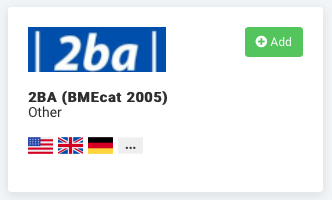
Next, learn how to set up the BMEcat 2005 - Bundled-features Approach export channel.
Compare BMEcat export channels
Before you start, be sure to choose the correct BMEcat 2005 channel to suit your needs.
BMEcat 2005 - Single-feature Approach export channel | BMEcat 2005 - Bundled-features Approach export channel |
|---|---|
Your BMEcat has fewer than 50 features | Your BMEcat has more than 50 features |
You do not have a separate site handling data mapping to a classification standard such as ETIM. | You have a separate site handling data mapping to a classification standard such as ETIM. See Set up ETIM Classes exports for setup instructions. |
If the BMEcat 2005 - Bundled-features Approach export channel is right for you, take the following steps in the next sections to set it up.
Prerequisites
If you plan to include a classification standard in your BMEcat 2005 export, you should already have a different site prepared using a classification standard before you begin with the BMEcat 2005 - Bundled-features Approach export channel set up. For example, you can use the ETIM-7.0 or ETIM-8.0 Classification export channel or another classification standard.
In this document, Productsup uses ETIM classifications to demonstrate the setup in principle. See Set up ETIM Classes exports for steps in preparing the site using the ETIM classification standard.
Set up BMEcat 2005 - Bundled-features Approach export channel
Prepare BMEcat 2005 data sources
Using the ETIM classification standard for your BMEcat 2005, you need to add that data to the current site from where you're working. You must then add the ETIM output from the site as an additional data source to your current site. To accomplish this:
Go to Exports from your site's main menu to perform the Export to Data Source feature. Then, complete the configuration for your ETIM site export destination, including the data source settings for the current site.
The platform later bundles all attributes into the following four fields:
FNAME- Attribute nameFVALUE- ValueFUNIT- Unit of measureFVALUE_DETAILS- Can contain additional valuable information or be empty
Bundling lets you pass the ETIM information to BMEcat without needing to map or review the data again. This step saves you time later in the setup.
Once you have added the additional data source with your ETIM data, go to Data Source and edit the data source by selecting the Edit cogwheel.
Next, continue to the Advanced Settings tab and select I/O Settings. Then select Add and copy-paste the following XSLT code in the Transform XML with XSLTXSL Template field:
<?xml version="1.0" encoding="UTF-8"?> <xsl:stylesheet xmlns:xsl="http://www.w3.org/1999/XSL/Transform" xmlns:xs="http://www.w3.org/2001/XMLSchema" exclude-result-prefixes="#all" xmlns:fun="urn:com:productsup:xslt:functions" version="2.0"> <xsl:output indent="yes" encoding="UTF-8" cdata-section-elements="Name" /> <xsl:strip-space elements="*"/> <xsl:template match="node()|@*"> <xsl:copy> <xsl:apply-templates select="node()|@*"/> </xsl:copy> </xsl:template> <xsl:template match="FEATURE"> <xsl:element name="FEATURE"> <xsl:apply-templates select="FNAME"/> <xsl:for-each select="FVALUE"> <xsl:if test=". = ''"> <xsl:element name="FVALUE"> <xsl:text>-</xsl:text> </xsl:element> </xsl:if> <xsl:if test=". != ''"> <xsl:element name="FVALUE"> <xsl:value-of select="." /> </xsl:element> </xsl:if> </xsl:for-each> <xsl:choose> <xsl:when test="FVALUE_DETAILS"> <xsl:element name="FVALUEDETAILS"> <xsl:value-of select="FVALUE_DETAILS"/> </xsl:element> </xsl:when> <xsl:otherwise> <xsl:element name="FVALUEDETAILS"> <xsl:text>-</xsl:text> </xsl:element> </xsl:otherwise> </xsl:choose> <xsl:choose> <xsl:when test="FUNIT"> <xsl:element name="FUNIT"> <xsl:value-of select="FUNIT"/> </xsl:element> </xsl:when> <xsl:otherwise> <xsl:element name="FUNIT"> <xsl:text>-</xsl:text> </xsl:element> </xsl:otherwise> </xsl:choose> <!--<xsl:apply-templates select="FUNIT"/>--> </xsl:element> </xsl:template> <xsl:template match="ARTICLES"> <xsl:element name="ARTICLES"> <xsl:apply-templates select="*"/> </xsl:element> </xsl:template> </xsl:stylesheet>
Back in your data source Edit view, go to the Overview tab and scroll down to Content Options.
Next, select XML Settings from the left-hand menu and enter the value
1into the Bundle repeating nodes field. Then enter<###>in the Bundle delimiter field and select Save all settings.
Now that you prepared the import sources, you can continue setting up the BMEcat 2005 export channel.
Go to Exports from your site's main menu and select ADD EXPORT. Search for BMEcat 2005 - Bundled-features Approach and select Add.
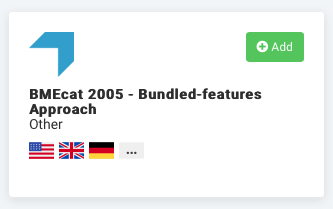
Give your export a custom name if desired. In this example, use the name BMEcat 2005 export. The custom name replaces the export name on the BMEcat - Bundled-features Approach Overview page. Then select Add.
Select Add Destination and choose your destination. For the following example, choose Productsup Server from the drop-down list. Give this destination a title in Name, for example, Internal FTP server, and select Save.
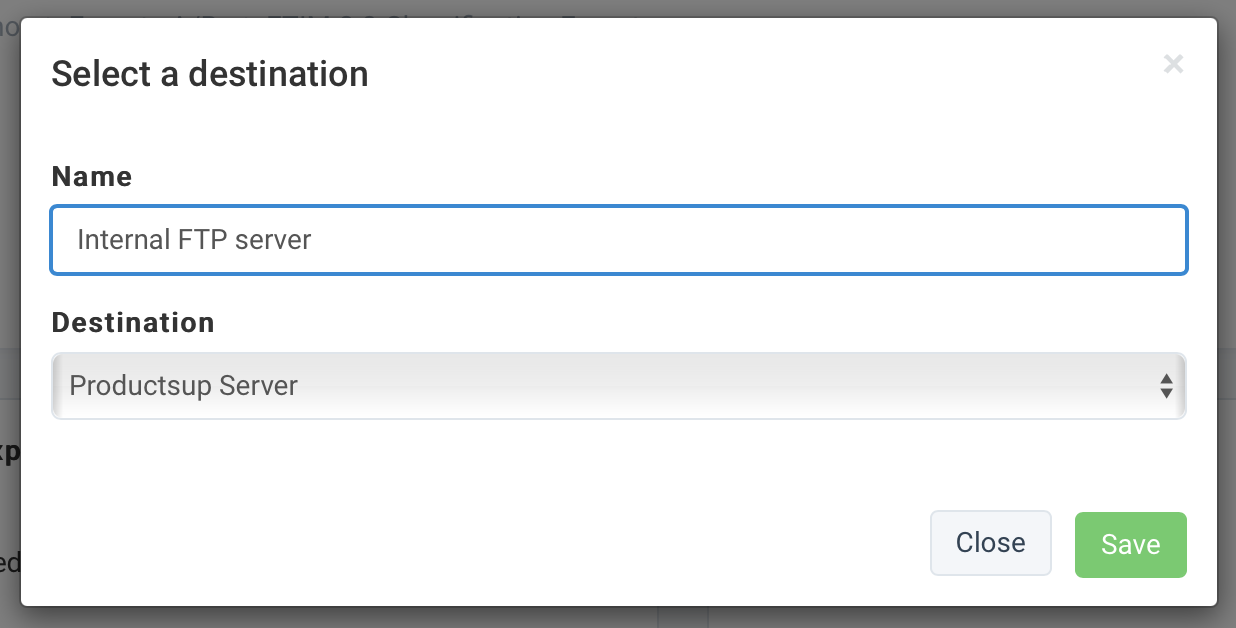
Go to the Settings tab and switch Export as XML to ON.
Continuing on the Settings page, enter the BMEcat header information beginning with the field GENERATOR_INFO.
The BMEcat header does not send product descriptions. It only sends information concerning the identification and validity of the catalog, the catalog creator, receiver, and the underlying skeleton agreement. In addition, the BMEcat header contains applicable default values that it can place on all held products, for example, language and currency.
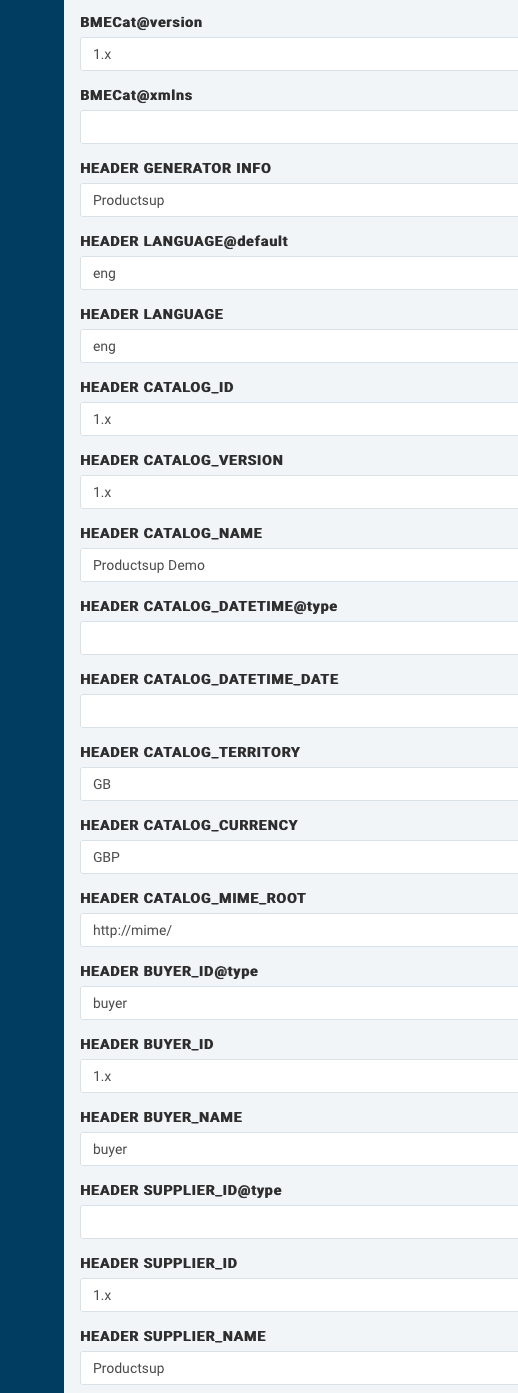

BMEcat 2005 - Bundled-features Approach export channels Settings page
Note
Correctly entering BMEcat header information depends on the intended recipient's requirements for the BMEcat you are creating. If you are uncertain of the requirements, see Header beginning on page 21 in the Specification BMEcat 2005 PDF document.
Select Save to store the header fields information that you entered.
Exit Exports and go to Dataflow from your site's main menu.
Map the BMEcat attributes and validate the data
Before continuing with the BMEcat setup, here is some essential information on mapping BMEcat elements.
To become familiar with the BMEcat 2005 structure, in this example, the export column contains the highest-level elements that hold a value under the main element PRODUCT. See the following illustration:
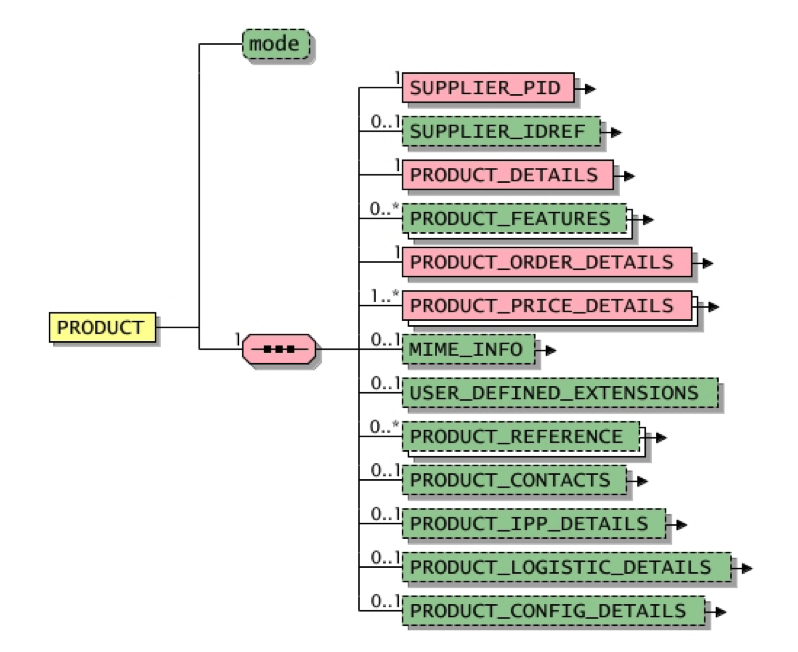
Accordingly, directly from the main element PRODUCT, the SUPPLIER_PID element appears in the export column because it carries a value. In contrast, the PRODUCT_DETAILS element does not appear in the export column because it is a structural element and does not hold a value. Lower-level elements under PRODUCT_DETAILS, such as DESCRIPTION_SHORT and DESCRIPTION_LONG, appear in the export column because these elements also hold a value.
Important
In the export column, you can see all of the possible BMEcat 2005 attributes. You mustn't create any additional attributes for this export channel manually, as the platform does not add them to the final BMEcat 2005 file. If you don't see an attribute that you need, contact your Customer Success Manager or support at support@productsup.com.
See PRODUCT in context, beginning on page 34 in the Specification BMEcat 2005 PDF document for more information.
Indexed attributes
What are indexed attributes?
Some attributes can have more than one instance, for example, descriptions, which can come in several languages for an item. You can refer to these attributes as indexed attributes. Some of the indexed attributes consist of several sub-attributes. An index number per attribute in the output file marks the relationship between these sub-attributes.
How is that reflected in the setup?
To prevent the user from having to create a field in the dataflow for every instance, Productsup is using a delimiter within the fields, to let the user add several instances. This is best explained with an example: The attribute Description Short can contain short descriptions for several languages. Sub-attributes are the description itself and the language. The user must populate the two sub-attributes DESCRIPTION_SHORT@lang and DESCRIPTION_SHORT, so the output file correctly populates. The platform imports the file to provide instance information in the same order for every sub-attribute.
Description Short DE: Hochwertiges WerkzeugDescription Short EN: High-quality toolDescription Short FR: Outil de haute qualité
You must add these to the sub-attributes, as follows:
|
|
|---|---|
|
|
If one of the sub-attributes is missing for an instance, you need to use an empty value. Skipping it leads to inconsistencies within the output file.
The following tables describe the indexed attributes and their sub-attributes:
Note
When using the ETIM-7.0 Classification or ETIM-8.0 Classification export, the XSLT that you previously saw in step 2 takes care of the product features. In this case, there is no need for manual adjustment.
Description Short |
|---|
|
|
Description Long |
|---|
|
|
Product Details |
|---|
|
|
Product Features |
|---|
|
|
|
|
Price |
|---|
|
|
|
|
|
MIME |
|---|
|
|
|
|
The following tables list the user-defined extensions:
MIME |
|---|
|
|
|
|
|
|
|
Description Very Short |
|---|
|
|
Packing Unit |
|---|
|
|
|
|
|
|
|
|
|
|
|
|
|
|
Product Characteristic |
|---|
|
|
|
|
|
|
|
|
|
|
|
To continue with the BMEcat setup by mapping attributes, take the following steps:
In Dataflow, map all the attributes you want to add to your BMEcat 2005 export.
For the bundled attributes that come from the classification site, map them from import to export, as all the values were previously bundled inside of the four (4) fields referred to in step 2.
Go to Data View to review the data and, if required, add rule boxes to adjust your values. To learn more about rule box possibilities, see Find the needed rule box category.